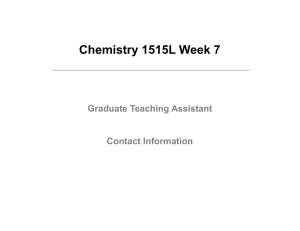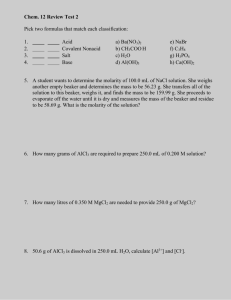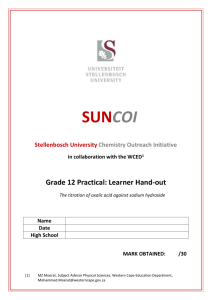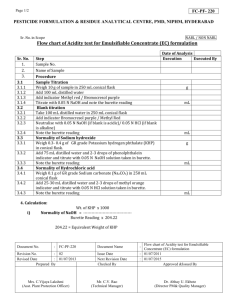respiration lab - VicPark-IBRoundtable-2009
advertisement
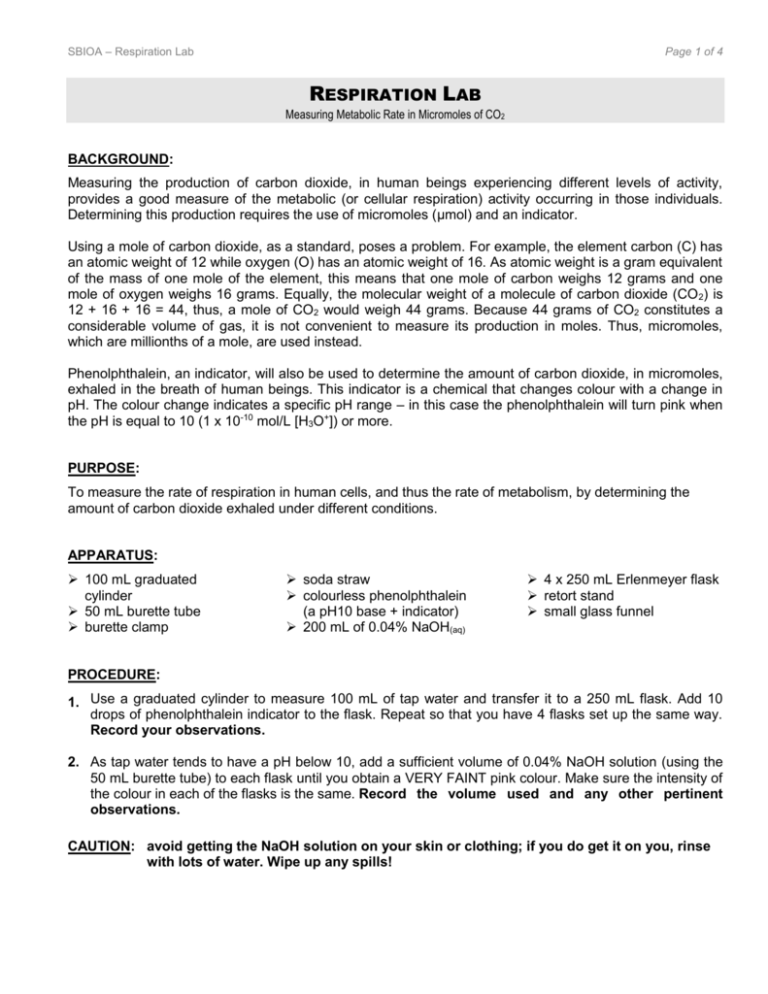
SBIOA – Respiration Lab Page 1 of 4 RESPIRATION LAB Measuring Metabolic Rate in Micromoles of CO2 BACKGROUND: Measuring the production of carbon dioxide, in human beings experiencing different levels of activity, provides a good measure of the metabolic (or cellular respiration) activity occurring in those individuals. Determining this production requires the use of micromoles (μmol) and an indicator. Using a mole of carbon dioxide, as a standard, poses a problem. For example, the element carbon (C) has an atomic weight of 12 while oxygen (O) has an atomic weight of 16. As atomic weight is a gram equivalent of the mass of one mole of the element, this means that one mole of carbon weighs 12 grams and one mole of oxygen weighs 16 grams. Equally, the molecular weight of a molecule of carbon dioxide (CO 2) is 12 + 16 + 16 = 44, thus, a mole of CO2 would weigh 44 grams. Because 44 grams of CO2 constitutes a considerable volume of gas, it is not convenient to measure its production in moles. Thus, micromoles, which are millionths of a mole, are used instead. Phenolphthalein, an indicator, will also be used to determine the amount of carbon dioxide, in micromoles, exhaled in the breath of human beings. This indicator is a chemical that changes colour with a change in pH. The colour change indicates a specific pH range – in this case the phenolphthalein will turn pink when the pH is equal to 10 (1 x 10-10 mol/L [H3O+]) or more. PURPOSE: To measure the rate of respiration in human cells, and thus the rate of metabolism, by determining the amount of carbon dioxide exhaled under different conditions. APPARATUS: 100 mL graduated cylinder 50 mL burette tube burette clamp soda straw colourless phenolphthalein (a pH10 base + indicator) 200 mL of 0.04% NaOH(aq) 4 x 250 mL Erlenmeyer flask retort stand small glass funnel PROCEDURE: 1. Use a graduated cylinder to measure 100 mL of tap water and transfer it to a 250 mL flask. Add 10 drops of phenolphthalein indicator to the flask. Repeat so that you have 4 flasks set up the same way. Record your observations. 2. As tap water tends to have a pH below 10, add a sufficient volume of 0.04% NaOH solution (using the 50 mL burette tube) to each flask until you obtain a VERY FAINT pink colour. Make sure the intensity of the colour in each of the flasks is the same. Record the volume used and any other pertinent observations. CAUTION: avoid getting the NaOH solution on your skin or clothing; if you do get it on you, rinse with lots of water. Wipe up any spills! SBIOA – Respiration Lab Page 2 of 4 3. Blow through a soda straw into one of the solutions for exactly one minute. Breathe in normally (without the tube in your mouth), but exhale through the tube. The easiest method is to exhale into the solution for 15 sec., then take a break, and repeat three more times. Blow gently so that water will not splash from the flask or bottle. Answer question 3 in the Observation section before going to step 4 of the procedure. 4. Carefully clamp a 50 mL burette tube to a retort stand. Fill the burette tube with the 0.04% NaOH solution. Record the volume of NaOH in the burette. Note: it is not important that the burette be filled exactly to 50 mL, but it is VITAL that you record the exact volume of NaOH that is in the burette. 5. Rapidly add the NaOH solution to the result of step 3 until a colour change to pink occurs in the first flask. This is your test flask which will give the approximate volume (mL) of NaOH to use in subsequent trials. Repeat step 3, with a second flask, except this time stop adding NaOH solution before the pink colour is observed. Continue to add the 0.04% NaOH drop by drop to the solution in the flask, using the burette tube, until the same intensity of VERY FAINT PINK colour appears as in the control flask. Swirl the water gently in the flask after each drop of NaOH. Continue to add NaOH until you are sure the pink colour will last for one minute. Avoiding parallax, record the number of mL, to one decimal place, of 0.04% NaOH solution added to turn the water pink and keep it pink for one minute, while swirling. Estimate any fractions of a milliliter very carefully. (Note: you may have to refill the burette more than once.) 6. Multiply by 10 the number of milliliters of 0.04% NaOH solution required to turn the solution pink and keep it pink for one minute after swirling. The product is the number of micromoles of C0 2 which you exhaled in one minute. Record your calculations. Note that the final answer will NOT have any number after the decimal. The answer will be to the nearest whole number. 7. Repeat steps 1-6 two more times using the same person. Determine the average from the last three flasks (why not include the first flask?). 8. Put your name on the blackboard class data chart and beside it record the average number of micromoles of CO2 (average of three trials) exhaled by you in one minute. Other members of the class will do likewise. Record the class data from the blackboard. 9. Using the class data, determine the class average of micromoles of CO2 exhaled/minute. Round the class average to the nearest whole number. 10. Examine question 3 in the DISCUSSION section. PERFORM THIS EXPERIMENT. OBSERVATIONS: Organize your results and use tables where appropriate. 1. Record your observations from step 1 of the procedure. 2. Record your observations from step 2 of the procedure. 3. a) What changes do you observe in the colour of the solution in step 3? b) How many seconds did it take for the colour to change? 4. Record the number of millilitres from step 4 of the procedure, 5. Record your 3 calculations and each answer from step 6 of the procedure 6. Record the average from number 7 of the procedure. 7. Record the class results and the class average of micromoles of CO 2 exhaled/minute from steps 8 and 9 of the procedure. 8. Record the observations and calculations from step 10 of the procedure. SBIOA – Respiration Lab Page 3 of 4 DISCUSSION: 1. When a pink colour was obtained in step 2 of the procedure, what did this tell you about the pH value of the solution? Was it acidic or basic? 2. a) After the gas is bubbled through the phenolphthalein and water in step 3 of the procedure, what does the final observation indicate about the pH value? b) Write an equilibrium equation to show what happens when CO2 is bubbled through the water. 3. a) Do all members of the class exhale the same amount of CO2 in micromoles/minute? b) Formulate several hypotheses that will account for the variation (seen in part a), above). c) Devise and conduct a simple experiment to test your hypothesis. This experiment may include one person who has been at rest for 5 minutes before performing the test (i.e. the experimental result from the procedure) and the same person who has been exercising vigorously for a minute or two before the test is run again. Are there differences between the micromoles of CO2 produced by these class members per minute? Record your results. d) Do the observations in part c) substantiate your hypothesis from part b)? Explain why? 4. a) What is the class average of micromoles of CO2 exhaled per minute? b) Since CO2 is a product of cellular metabolism, what does the amount of CO2 exhaled/minute tell you about the metabolism of the individual concerned? 5. You may have heard (or read in the text!) of ‘basal metabolic rate’ (BMR), which is the value of how rapidly the resting body uses oxygen. Explain how CO2 production of can be considered a measure of BMR. 6. Discuss the concept of "oxygen debt". Using the example of a rower sprinting to the finish of a race. Include details of the process. (reference – “Muscles & Oxygen Debt” handout) SOURCES OF ERROR: List at least 2 major sources of experimental (NOT human) error and suggest remedies. For example: spillage, miscalculation, etc. are sources of human error while procedural problems are experimental error. LAB REPORT: 1. Each team will write up one formal lab report, using the class data. Each team member will submit their own answers to the ‘Discussion’ and ‘Sources of Error’ sections. 2. The lab report should be submitted in some sort of folder or binder, be word processed and consist of: Title Page – includes a highly descriptive title, describing the experimental factors studied – identification (names, course code, date of submission, instructor’s name) Purpose – begins with “To . . .” and is stated in your own words Materials – a complete list of all apparatus necessary for conducting the experiment (include sizes, amounts, etc. but DO NOT include common items such as: water, pencil) Method – a step-by-step set of instructions which allows any experimenter to perform the lab activity (should be stated in the past passive – e.g. “NaOH was titrated . . .”) – “Refer to lab outline” is acceptable when complete instructions are included Observations – all data collected should be organized in an easy to interpret manner – a complete “Observations” section (Parts 1-8) Discussion Error Sources – possible experimental, NOT human, error, with suggested remedies, included – answers to all discussion questions should be written using complete sentences, with proper grammar and spelling SBIOA – Respiration Lab Page 4 of 4 PROCEDURE: 1. Set up four 250 mL Erlenmeyer flasks as follows: add 10 drops phenolphthalein (colourless) Observation: should remain colourless 250 mL flask 100 mL tap water 2. add 0.04% NaOH drop by drop (will take approx. 8-14 drops or 0.5 mL to make it turn pink; note - number of drops is not important as only adding to make solution slightly basic. Even if it took 50 drops, it’s OK) just turns pink; therefore, basic 3. blow through straw for 1 minute (4 x 15 sec.) Observation: solution becomes colourless 4. 0.04% NaOH in burette (record initial volume) Observation: Record volume of 0.04% NaOH used to just produce a pink colour lasting a full minute takes approx. 60 mL 5. Sample calculation: Volume of 0.04% NaOH titrated = 60 mL. Therefore: 60 mL x 10 = 600 micromoles of CO 2

